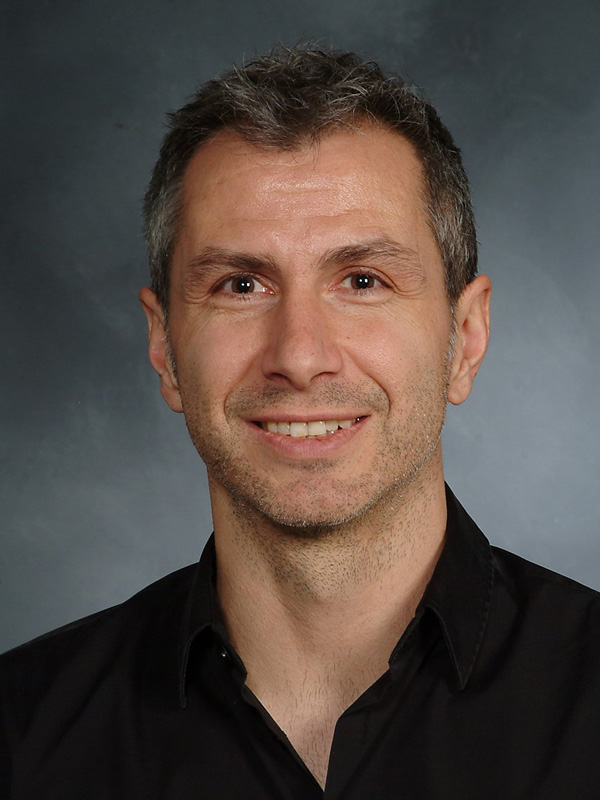
SPEAKER PROFILE *** Keynote Speaker *** |
 Prof. Simon Scheuring Weill Cornell Medicine, Department of Anesthesiology, Department of Physiology & Biophysics USA |
High-speed atomic force microscopy captures conformational transitions and transient conformational states in membrane proteins
Abstract
High-speed atomic force microscopy (HS-AFM) is a powerful technique that provides dynamic movies of biomolecules at work. We successfully used HS-AFM to determine structures and dynamics of membrane trafficking proteins, transporters, and channels. I will briefly review our recent developments to break current temporal limitations to characterize molecular dynamics by developing HS-AFM line scanning (HS-AFM-LS) and HS-AFM height spectroscopy (HS-AFM-HS) [1,2,3,4], and resolution limitations by developing Localization AFM (LAFM) [5]. Currently, we exploit these new possibilities for the analysis of conformational transitions and the discovery of rare, transient conformational states. As I will show, the dynamic single-molecule imaging capability of HS-AFM, avoiding temporal and ensemble averaging, opens new avenues in membrane biology [6].
References:
[1] Heath et al. Nature Communications, 2018, 9(1):4983, High-Speed AFM Height Spectroscopy (HS-AFM-HS): Microsecond dynamics of unlabeled biomolecules.
[2] Perrino et al., Nature Communications, 2021 12(7225), doi.org/10.1038/s41467-021-27580-2, Single molecule kinetics of bacteriorhodopsin by HS-AFM.
[3] Jiao et al., Nature Communications, 2022, 13(5039). doi.org/10.1038/s41467-022-32757-4, Perforin-2 clockwise hand-over-hand pre-pore to pore transition mechanism
[4] Jiang et al., Nature Communications, 2022, 13(7373), doi.org/10.1038/s41467-022-35202-8, Membrane-mediated protein interactions drive membrane protein organization
[5] Heath et al. Nature, 2021, 594(7863):385–390, doi:10.1038/s41586-021-03551-x, Localization Atomic Force Microscopy.
[6] Lansky et al., in preparation
Simon Scheuring’s laboratory is specialized in Atomic Force Microscopy (AFM) based technologies for the study of various membrane phenomena, such as membrane protein structure, assembly, diffusion, and conformational dynamics. Over the past years, his laboratory has been instrumental in the development and application of High-Speed Atomic Force Microscopy (HS-AFM). Further developments concerned novel AFM-based modalities, integrating optical microscopy into a HS-AFM, developing high-speed force spectroscopy (HS-FS) and high frequency microrheology (HF-µR), HS-AFM line scanning (HS-AFM-LS) and HS-AFM height spectroscopy (HS-AFM-HS) which allow to probe molecular dynamics at millisecond and microsecond temporal resolution. Most recently, Simon Scheuring’s laboratory introduced Localization Atomic Force Microscopy (LAFM) a super-resolution method that allows to extract high-resolution structural details from AFM data.
References:
[1] Heath et al. Nature Communications, 2018, 9(1):4983, High-Speed AFM Height Spectroscopy (HS-AFM-HS): Microsecond dynamics of unlabeled biomolecules.
[2] Perrino et al., Nature Communications, 2021 12(7225), doi.org/10.1038/s41467-021-27580-2, Single molecule kinetics of bacteriorhodopsin by HS-AFM.
[3] Jiao et al., Nature Communications, 2022, 13(5039). doi.org/10.1038/s41467-022-32757-4, Perforin-2 clockwise hand-over-hand pre-pore to pore transition mechanism
[4] Jiang et al., Nature Communications, 2022, 13(7373), doi.org/10.1038/s41467-022-35202-8, Membrane-mediated protein interactions drive membrane protein organization
[5] Heath et al. Nature, 2021, 594(7863):385–390, doi:10.1038/s41586-021-03551-x, Localization Atomic Force Microscopy.
[6] Lansky et al., in preparation
Bio
Simon Scheuring is Professor of Physiology and Biophysics in Anesthesiology at Weill Cornell Medicine, New York, USA. He is a trained biologist from the Biozentrum at the University of Basel, Switzerland. During his Ph.D. in the laboratory of Andreas Engel, he learned electron microscopy and atomic force microscopy, and got interested in membrane proteins. As postdoc and research assistant at INSERM and the Institut Curie in Paris, France, in the laboratory of Jean-Louis Rigaud, he learned membrane physical chemistry and developed atomic force microscopy for the study of native membranes. Simon then founded his own lab at the Institut Curie in Paris, France, and then built a larger independent laboratory at INSERM/Aix-Marseille Universite? in Marseille, France. In 2017 he moved to Weill Cornell Medicine, New York, USA, where he got appointed as Professor of Physiology and Biophysics in Anesthesiology.Simon Scheuring’s laboratory is specialized in Atomic Force Microscopy (AFM) based technologies for the study of various membrane phenomena, such as membrane protein structure, assembly, diffusion, and conformational dynamics. Over the past years, his laboratory has been instrumental in the development and application of High-Speed Atomic Force Microscopy (HS-AFM). Further developments concerned novel AFM-based modalities, integrating optical microscopy into a HS-AFM, developing high-speed force spectroscopy (HS-FS) and high frequency microrheology (HF-µR), HS-AFM line scanning (HS-AFM-LS) and HS-AFM height spectroscopy (HS-AFM-HS) which allow to probe molecular dynamics at millisecond and microsecond temporal resolution. Most recently, Simon Scheuring’s laboratory introduced Localization Atomic Force Microscopy (LAFM) a super-resolution method that allows to extract high-resolution structural details from AFM data.